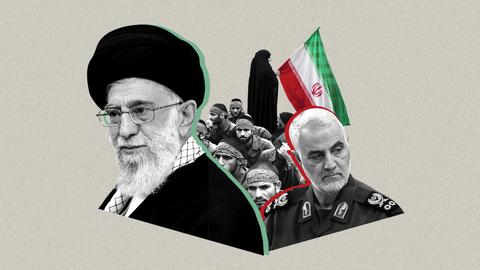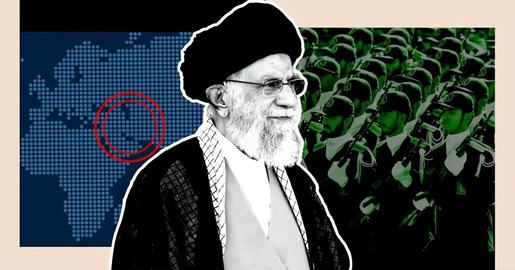Over recent weeks, the United States and Israel have been conducting an undeclared war against Iranian assets in Syria. Amid growing tensions, however, both Washington and Tehran have stated their intention to avoid a full-scale conflict.
Dozens of US and Israeli airstrikes have targeted senior Iranian-backed military leaders, heavy weapon storage locations and other Iranian interests in Syria and Iraq over the past three months.
While the strikes targeting Iranian-backed factions in Syria have been frequent for the past 10 years, the latest offensives indicate a marked escalation aimed at undermining Iranian operations in the war-ravaged country. This uptick in military action coincides with the ongoing conflict in Gaza and repeated attacks on US military installations in the Middle East.
Earlier this week, an Israeli plane struck a residential building in Kafr Sousa district, west of Damascus, according to multiple sources.
قتل ثلاثة أشخاص وأصيب آخرون نتيجة الغارة الإسرائيلية التي استهدف شقة في مبنى سكني في حي كفرسوسة بمدينة #دمشق صباح اليوم. pic.twitter.com/w1qtIhftBh
— مهاب ناصر -Mohab Nasser (@Mohab_Nasser2) February 21, 2024
A source from the Syrian military, who requested anonymity for safety reasons, told IranWire that the strike targeted an apartment in a residential building adjacent to an Iranian school.
Three people were killed in the attack, including two non-Syrian nationals and “a Syrian civilian who was fatally injured by shrapnel while passing through that area,” the source said.
"The neighborhood, known for housing intelligence centers and Syrian military command posts, is regularly visited by Iranian officers and members of Iran-aligned militias.”
Other local sources told IranWire that the location was targeted in two separate attacks on Tuesday night and in the early hours of Wednesday.
Aerial attacks take place almost daily on the outskirts of Damascus or other parts of Syria where Iranian-backed militias are based. The Syrian government frequently attributes these attacks to Israel.
An officer from Syria’s Fourth Division commanded by Maher al-Assad, the brother of President Bashar al-Assad, said in a text message to IranWire: “These sites are used by Iran and allied militias for their military and security operations.”
According to the officer, they include "a weapon storage facility affiliated with Hezbollah, a Lebanese party. The facility houses air defense missiles and drones, overseen by IRGC. Additionally, there is another base near the village of Kherbet al-Ward, which accommodates dozens of fighters affiliated to Iran.”
A member of the Syrian intelligence services claimed that he made frequent visits to what he described as an Iranian weapons depot, which receives shipments through Damascus International Airport.
There are also several command centers for the IRGC, including training camps located south of the Sbeineh area near the capital.
“There is also another arm storage facility, situated in an open area south of Damascus, overseen by the Fatemiyoun Brigade, an Iran-backed group” the official added.
On February 14, an airstrike resulted in the deaths of two Iranian militia members in rural areas near Deir Ezzor. According to a member of a local militia which receives support from Iraq, American forces attacked the Ein Ali base, near the Iraqi border, which has been used to launch attacks on American soldiers.
According to an activist monitoring the Iranian presence in Syria, “this attack came after a night of intense exchange of artillery fire between American and Iranian forces.”
“The hostilities began when local forces aligned with Iran launched an attack on the Omar oil field, where American forces are stationed,” the activist added.
In a message sent to IranWire, a local commander of a Tehran-aligned militia in Syria said that “the person responsible for launching the missile attacks toward the Omar oil field, where American forces are stationed, is a Lebanese member of Hezbollah tasked with providing training on the use and deployment of Iranian Mithaq missiles and other offensive projectiles.”
One of the most intense strikes against Iranian interests in Syria occurred in Damascus on January 20, when five IRGC members were killed.
In a statement, the Revolutionary Guards condemned what they described as "the brutal and criminal Zionist aggression on Damascus."
On February 9, Israeli aircraft conducted a strike on a villa near the Syrian capital, which was being used by Iranian militias and Hezbollah fighters, the Syrian intelligence officer said.
On February 6, an Israeli air strike hit a villa in Homs which served as a base for Iranian militia leaders. The attack led to the death of a first lieutenant in the Syrian air defense forces and the destruction of many military vehicles and air defense weapons.
On the morning of February 2, another Israeli air raid on Sayyida Zeinab, in the outskirts of Damascus, resulted in the death of Saeed Ali Dadi, a military advisor for the Revolutionary Guards.
An Israeli attack near Damascus on January 29 also resulted in the deaths of several IRGC members.
In early February, a series of US airstrikes targeted multiple positions of Tehran-affiliated militias in Deir Ezzor, in response to a drone attack on a base in Jordan on January 28 which resulted in the death of three American soldiers.
The United States said it had targeted facilities associated with the IRGC’s Quds Force and affiliated factions operating in Iraq and Syria.
Long-range B1 bombers that departed from the US were involved in the bombing operation, according to a statement.
The strikes focused on 85 targets spread across four locations in Syria and three in Iraq. The operation was executed within 30 minutes, the statement said.
A Syrian military official said that the airstrikes focused on ”arms and ammunition storage facilities used by Iranian militias,” "demolished a villa in Mayadeen, a city in the countryside of Deir Ezzor, that was owned by the commander of the Abu Fadl al-Abbas militias," and targeted a building referred to as "the Iranian kitchen," which served as a central food preparation site for the Iranian militias in the entire city.
In Iraq, the bombing targeted a headquarters of the Iraqi Hezbollah. “The airstrike resulted in the death of a military leader known as Abu Baker, who commanded the drone unit of the Hezbollah brigades,” according to the official.
In a series of statements issued in 2020, Iranian and Syrian officials said that the Islamic Republic’s presence in Syria was limited to military advisors supporting the Syrian army in their operations.
In a recorded interview with Russia Today on October 8, 2020, President Bashar al-Assad said no Iranian forces were stationed on Syrian territory and that Tehran had dispatched military experts to provide advisory support to the army.
During a press conference in November 2020, Iranian Foreign Ministry spokesman Saeed Khatibzadeh stated that Tehran had deployed special forces in Syria to serve as military advisors, for as long as needed. He also warned that the Islamic Republic would deliver a "crushing response" to anyone hindering its mission in Syria.
A 2021 investigation by IranWire uncovered that, instead of deploying its own forces in Syria, the Islamic Republic has shifted toward providing support for local groups, as well as Lebanese, Iraqi and Afghan militias, which are controlled by Tehran.
visit the accountability section
In this section of Iran Wire, you can contact the officials and launch your campaign for various problems





















comments